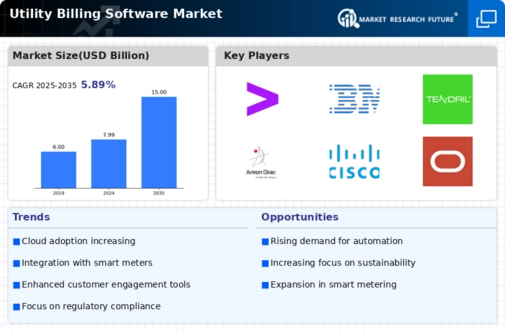Market Trends and Projections
Regulatory Compliance and Standards
Regulatory compliance remains a critical driver in the Global Utility Billing Software Market Industry. Governments worldwide are implementing stringent regulations to ensure transparency and fairness in utility billing practices. This necessitates the adoption of advanced billing software that can adapt to changing regulations and provide accurate reporting capabilities. As utilities strive to meet compliance requirements, the demand for robust billing solutions is expected to rise. The Global Utility Billing Software Market Industry is likely to benefit from this trend, as companies invest in software that not only meets current standards but is also scalable for future regulatory changes.
Expansion of Renewable Energy Sources
The expansion of renewable energy sources is reshaping the Global Utility Billing Software Market Industry. As utilities diversify their energy portfolios to include solar, wind, and other renewable sources, the complexity of billing processes increases. This necessitates the implementation of sophisticated billing software capable of managing diverse energy inputs and pricing structures. The transition to renewable energy not only supports sustainability goals but also drives the demand for innovative billing solutions. The Global Utility Billing Software Market Industry is poised for growth as utilities seek to integrate these technologies into their operations, ensuring accurate billing for renewable energy consumption.
Growing Demand for Smart Metering Solutions
The Global Utility Billing Software Market Industry experiences a notable surge in demand for smart metering solutions. As utilities increasingly adopt advanced metering infrastructure, the need for sophisticated billing software becomes paramount. Smart meters facilitate real-time data collection, enabling utilities to enhance billing accuracy and customer satisfaction. In 2024, the market is projected to reach 7.99 USD Billion, reflecting the industry's shift towards technology-driven solutions. This trend is likely to continue, as smart metering is expected to play a crucial role in the transition to sustainable energy practices, thereby driving further growth in the Global Utility Billing Software Market Industry.
Rising Consumer Expectations for Transparency
Consumer expectations for transparency in utility billing are on the rise, significantly influencing the Global Utility Billing Software Market Industry. Customers increasingly demand detailed billing information and clarity regarding charges. This shift compels utility companies to adopt advanced billing software that provides comprehensive insights into usage patterns and billing breakdowns. As a result, utilities are investing in solutions that enhance customer communication and foster trust. The anticipated growth of the market, projected to reach 15 USD Billion by 2035, underscores the importance of meeting these evolving consumer demands within the Global Utility Billing Software Market Industry.
Integration of Artificial Intelligence and Machine Learning
The integration of artificial intelligence and machine learning technologies is transforming the Global Utility Billing Software Market Industry. These technologies enable utilities to analyze vast amounts of data, predict customer behavior, and optimize billing processes. AI-driven solutions can enhance customer engagement through personalized billing experiences and proactive communication. As the market evolves, the adoption of AI and machine learning is anticipated to grow, potentially contributing to a compound annual growth rate of 5.89% from 2025 to 2035. This technological advancement positions the Global Utility Billing Software Market Industry for sustained growth and innovation.























